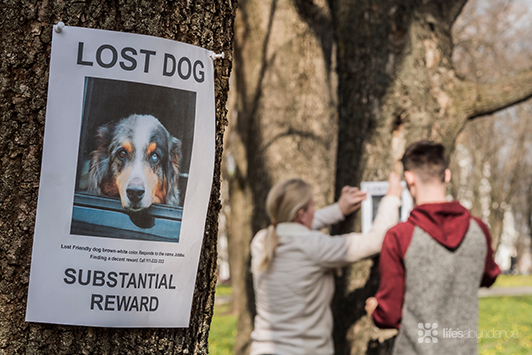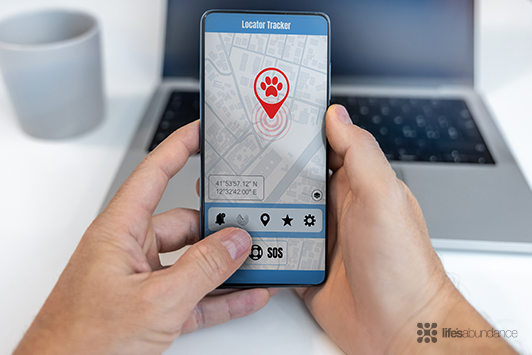
From posters to GPS – modern pet lost and found is reuniting more pets.
Every pet parent knows the feeling—that split-second panic when you can't find your furry companion. Maybe they slipped out the door… or maybe they're just passed out in the bathtub, completely unbothered. (Or better yet, deeply committed to guarding the Amazon box you just recycled.)
Most of the time, it's a false alarm—and your pet turns up within minutes. But on the rare occasion that they don't, it's reassuring to know that the way we search for lost pets has come a long way—and continues to evolve.
From stapled flyers and word-of-mouth to GPS collars, and online search networks, the world of pet lost and found looks very different than it used to. In this post, we're taking a look at where it all started, how it's changed over the years, and what today's pet recovery landscape looks like.
Old-School Lost Pet Search: More Heart Than Reach
Not so long ago, searching for a lost pet meant grabbing a stack of flyers, a roll of tape, and maybe a flashlight—then setting out on foot with equal parts hope and adrenaline.
You'd post signs on telephone poles, at bus stops, and on community boards. Stop by local businesses with a photo in hand, and routinely check in with every nearby shelter. Some people ran ads in the newspaper or called into local radio stations. It was an all-hands-on-deck approach, powered by neighborly kindness and pure determination.
And while those efforts absolutely helped bring pets home, they had their limits. Searches were local. News traveled slowly. And unless someone happened to see your poster—or your pet—it often came down to timing and a little bit of luck.
Thankfully, an innovation soon came along that significantly improved the chances of lost pets finding their way back home.
The Microchip: Major Impact on Pet Recovery
Interestingly, the idea of implanting ID into animals didn't start with pets—it started with livestock. In the 1970s, researchers were looking for ways to track and identify animals on farms more efficiently. By the early '80s, the technology began making its way into the pet world, starting in Europe and eventually gaining traction in the U.S.
It wasn't until 1990 that microchipping became more widely accepted in the veterinary space, when the American Veterinary Medical Association officially endorsed it. That vote of confidence marked a turning point—bringing microchips from a niche tool to a mainstream option for pet identification.
And the results? They've really made a difference.
Before microchipping, lost cats had about a 2% chance of making it back home. Today, that number is closer to 40%. For dogs, the return rate jumped from around 14% to over 50%. Microchips don't track your pet in real time, but they do offer a permanent, scannable link back to you—if your contact info is kept current.
In fact, microchipping became so standard that in 2016, the UK made it legally mandatory for all dogs. It's now part of everyday best practices for shelters, rescues, breeders, and veterinary clinics across the world.
But since microchips only help after your pet is found—what if you could track them before that happens? Now, thanks to the age of smart tech, you can.
GPS collars allow pet parents to monitor their pet's location in real time, often from their phone. Some even let you set up "safe zones" around your home or yard—and send an alert the moment your dog or cat crosses the boundary.
It's peace of mind in your pocket.

Smart tech, like GPS tracking, is helping find lost pets faster than ever.
The Power of Community: From Posters to Push Notifications
When a pet goes missing, every minute feels like an hour. But in today's connected world, help can spread faster than ever—and often from people you've never even met.
Social media has turned neighborhood posters into powerful digital alerts. Local Facebook groups, neighborhood apps like Nextdoor, and even TikTok and Instagram hashtags can mobilize entire communities within minutes. A single post can reach hundreds—or even thousands—of people in your area, including the ones most likely to spot your pet.
In fact, some communities have built entire networks dedicated to helping lost pets find their way home. PawBoost and Finding Rover are just a couple of examples—platforms that allow pet parents to report lost pets and instantly broadcast alerts to volunteers, shelters, and nearby users. Some even use facial recognition technology to match found pet photos with lost reports.
Many animal control agencies and shelters now use text alert systems or push notifications to spread the word when a found pet matches one that's been reported missing. Digital flyers, real-time updates, and neighborhood-based sharing make it easier than ever to coordinate searches and follow up on leads.
The result? A growing number of success stories—often with happy reunions happening in a matter of hours, not days.
These tools don't replace microchips, GPS collars, or good old-fashioned legwork—but they complement them. And together, they've created something pretty remarkable: a compassionate, tech-savvy community ready to step up when it matters most.
A Changed Landscape, A Shared Goal
Pet recovery has come a long way. From handwritten posters and neighborhood walks to microchips, GPS collars, and community-driven apps, the way we search for lost pets has evolved into something faster, smarter, and more connected than ever before.
This post isn't about telling anyone what they should do. Every pet, every situation, and every family is different. But if the unthinkable ever happens, it helps to know what's out there—and what tools might help bring your furry companion back home.
Because no matter how much the technology changes, the goal stays the same: to be reunited with the ones we love.
If you found this interesting, check out these related stories:
How to Take a Road Trip with Your Dog
7 Essentials for Your Pet’s “Bug Out” Bag